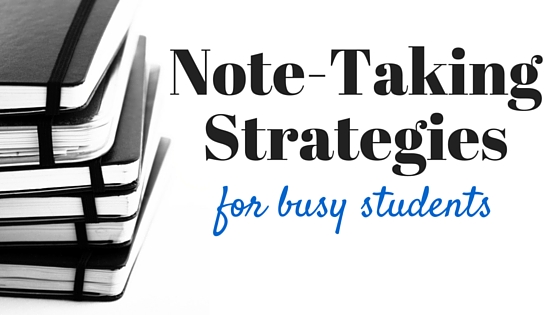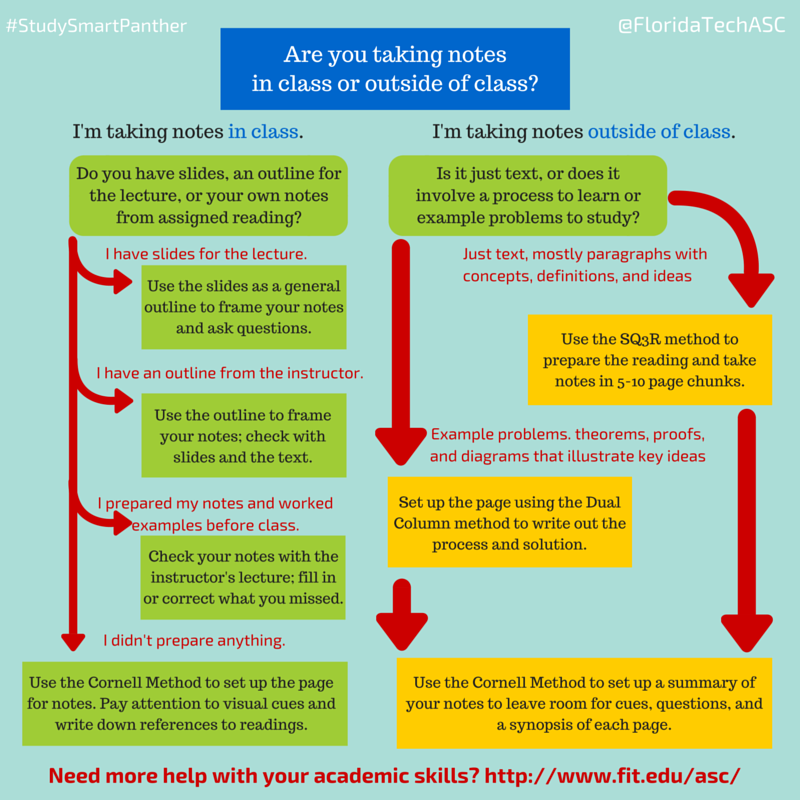Note-Taking Strategies for Busy Students
It may seem obvious that note-taking is an important skill for any university student. Regardless of your discipline or courseload, the ability to keep a record of what you read in a text and experience in a lecture is critical to your long-term academic success. Many students don’t learn reliable note-taking strategies before they get to college, and other students learn strategies but don’t understand how to properly apply them to the right situation. It takes time and a willingness to try several methods before you find a note-taking strategy that best meets your learning preferences and coursework, so it’s not realistic to expect a single workshop or blog post to solve all of your academic needs. What this post can do is introduce you to some of the most common strategies and explain where and how they can work for you.
First, consider if you are taking reading notes or lecture notes. As the name suggests, reading notes are notes taken while reading an assignment or passage. You can go back and forth at your own pace, highlight or underline key terms or ideas, and take time to better organize an idea to meet your learning needs. Reading notes help you to slow down and analyze material to provide a better summary of what you’ve read, and having reading notes before going into a lecture can give you an idea of how the lecture will be organized. On the other hand, lecture notes are those notes that you take based upon what happens during class. You have a limited amount of time to listen, consolidate, summarize, and record the information. The organization may depend more heavily on how the instructor presents the information and you have visual and nonverbal cues that suggest the importance of certain topics within the context of the class. Lecture notes can be difficult to structure when the class includes discussions and worked examples, so you may need to treat lecture notes as a ‘first draft’ that you can rewrite later as part of your review strategy.
Second, consider an organization method for your notes. We offer three that you can use with suggestions on where they would best work.
SQ3R Method – best used for reading notes, since the strategy requires that you go through the material and used headings as a way to structure your notes.
Steps in this method:
- Survey the text – skim the material, take note of definitions, charts, diagrams, pictures, equations, and other parts of the text that jump out at you
- Questions – using headings, definitions, charts, and illustrations, create questions to guide your reading
- Read – go through the text based upon the questions that you created
- Recite – write down the answer to the question, preferably in your own words rather than simply copying down the passage from the text, and remember that some answers are better represented with illustrations and diagrams
- Review – once you’ve answered your questions, go back and check what you’ve written to see that it makes sense and communicates a complete idea
Cornell Method – can be used for reading notes alongside the SQ3R strategy, but provides structure for lecture notes (especially when revision after lecture is necessary)
- Divide the page into three areas. A two inch margin on the left and a three inch footer on the bottom provides an area to the right where notes are written. This empty space means that you can take notes in an outline format, short sentences, lists, diagrams, or solved problems.
- During the lecture, use the largest space for notes. Any questions or items to be emphasized should be noted on the left margin, since these cues can help recall key information.
- After class, use the left margin to create questions that summarize parts of the notes contained in the main area.
- Finally, use the footer to create a summary of the ideas and concepts. The summary should be a few sentences and be in your own words; it can be used as a quick index of your work as you skim through your notes.
Dual Column Method – can be used for either reading notes or in-class notes, but is most useful when working through processes, mathematical equations, and application-type problems common to many engineering and physics courses
- Rewrite the problem, then divide the page down the middle.
- On the left side, solve the problem in discrete steps. Many students find this part tedious, but the intent of this method is to slow down your thinking and facilitate transfer, or how you can relate one situation to another based upon the underlying structure.
- On the right side, write out each step in sentence format. Use good verbs that relate to your discipline; math terms like ‘substitute’ are better than ‘plug’ or ‘put’ when replacing values in an equation, for example. Make sure that each step is numbered and corresponds to the correct step on the left side.
- Remember to include (and label!) diagrams that you need, and write a few sentences that correspond to the labels that you place on the diagram.
- Finally, remember that note-taking is an iterative process. Good notes outline and summarize information, so consider rewriting your notes or creating concept maps to reorganize and better learn the information.
If you would like help learning how to use any of these methods, be sure to come by the Academic Support Center or make an appointment at http://hub.fit.edu/asc/. Want to know when our next note-taking workshop will be? Check our site at http://www.fit.edu/asc.






